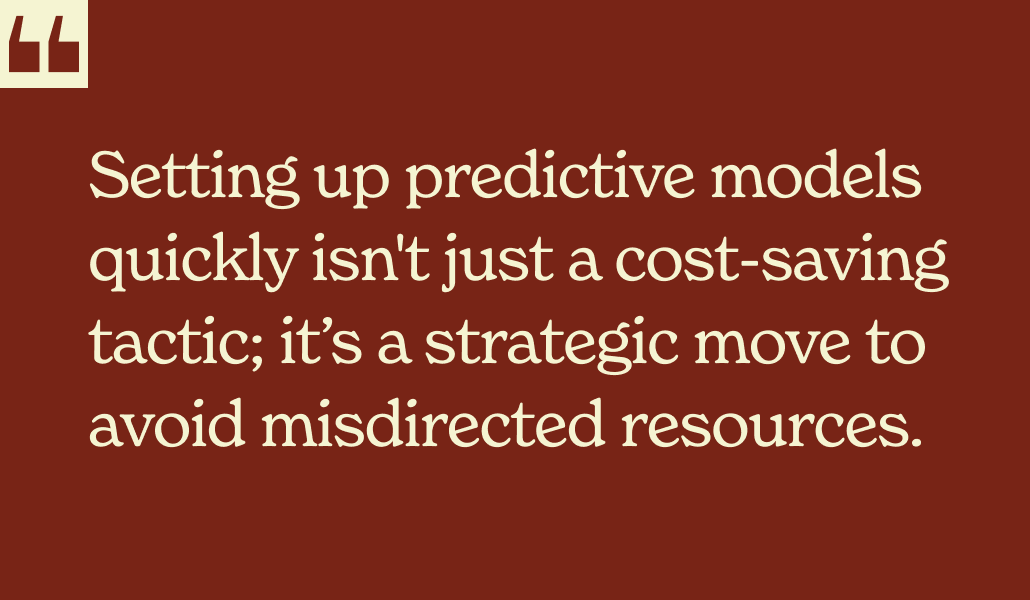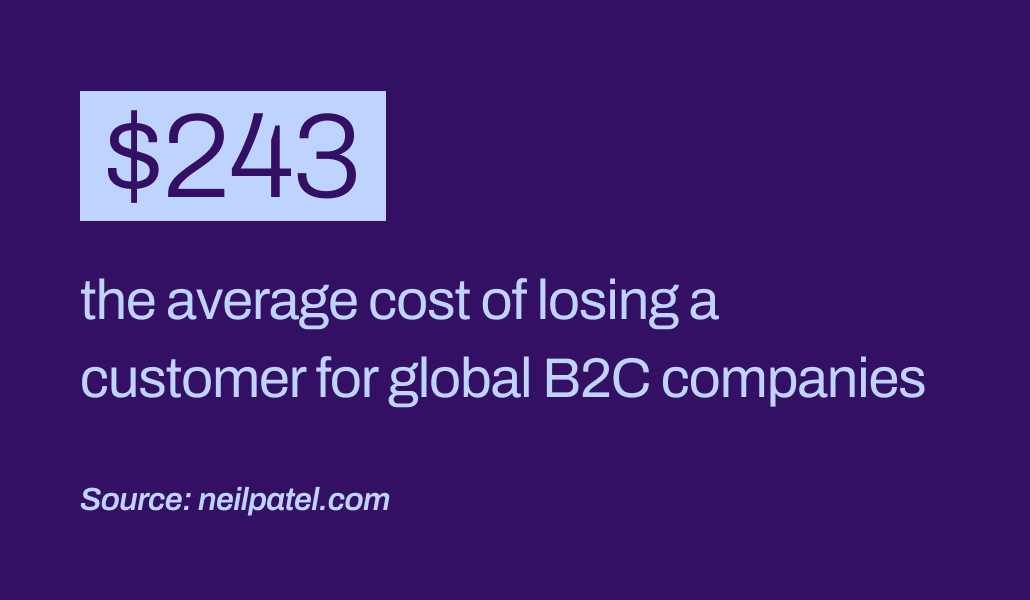In a nutshell:
- Predictive analytics platforms are crucial for capturing the value of data and outperforming competitors.
- Speed is essential in implementing and deploying predictive analytics.
- Internal teams with low-code AutoML platforms or external analytics teams can help achieve speed and agility.
- Speed in predictive analytics helps avoid missed revenue opportunities and operational inefficiencies.
- Quick response to changes in customer behavior is vital for customer-centric businesses.
Are you considering bringing a predictive analytics platform into your tech stack? If so, that's one of the best steps you can take in 2024 to capture the value of your company’s most valuable asset — data.
Notably, businesses excelling in data practices and AI consistently outperform their competitors. According to McKinsey, companies already seeing 20% of their earnings before interest and taxes (EBIT) from AI are much more likely to have robust data practices supporting this achievement.
However, strong data practices are just one part of predictive analytics success. When it comes to implementing and deploying predictive analytics, speed can’t be ignored. Choosing a fast and adaptable implementation approach is essential, and ensuring your predictive models are accessible and timely is equally important.
Whether you decide to go with an in-house or external predictive analytics team, here are three reasons why speed is the bedrock of any predictive analytics strategy.
A Quick Note on Choosing Between Internal Vs. External Predictive Analytics
There are many valid reasons to take advantage of an internal data team or hire an external predictive analytics provider — because here’s the thing: Data, while abundant, rarely (if ever) arrives gift-wrapped with a clear roadmap. Without the appropriate know-how, even deciphering gathered data is insufficient for informed decision-making. And even with a comprehensive understanding of the business problem and data, building and deploying models can be a painstakingly time-intensive process.
For internal business analysts who understand the business case and data, this is where low-code AutoML platforms truly shine. Whether they’re on a dedicated analytics team or embedded within a business team (e.g., marketing or sales), AutoML platforms can surface and help them identify the best algorithms and models, help them quickly identify high-impact features, and jumpstart the tedious coding process — all to help your analysts start finding insights fast.
Likewise, external analytics teams bring years of experience and industry expertise to help you quickly identify high-impact use cases and get your models up and running. This agility is critical in ensuring you don’t lose out on revenue opportunities, that you can mitigate inefficiencies, and that you can respond to any changes in customer behavior. Let’s explore the need for speed in predictive analytics in further detail.
Reason #1: The Opportunity Cost of Average
Predictive analytics technology partners play a pivotal role in setting up predictive models. For example, imagine that you're implementing predictive lead scoring at your company. This approach helps your team quickly identify and prioritize "hot" leads, effectively channeling energy and resources toward the right avenues. Equipped with specialized knowledge and experience in the best analytics tools, algorithms, and methodologies, these partners ensure precision in identifying high-potential leads through predictive lead scoring.
In the absence of such insights, companies run the risk of inadvertently mismanaging lead priorities, potentially impacting revenue streams. By bypassing the hurdles of an internal team's learning curve, these partners facilitate the fast assessment of lead quality, enabling agile responses to promising opportunities. This agility is critical in circumventing missed revenue prospects that might arise due to delays or inefficiencies within internal processes.
Or consider other use cases for predictive analytics, such as optimizing your marketing campaigns. With timely insights that show up in days rather than weeks — like predicted ROAS (return on ad spend) or insights into optimal channels — you can tweak your campaigns to capture revenue that would have otherwise gone unclaimed.
Reason #2: Put a Lid on Operational Inefficiencies
Speed in the AI implementation process isn't just about ticking off a checklist; it's also the key to strengthening operational inefficiencies.
For example, consider the case of inventory management and logistics. AI ensures accurate demand forecasting and fosters agility. Hand in hand with opportunity costs, without advanced (and specific and adaptable) AI models, businesses face the perils of overstocking, understocking, or other organizational disruptions and inefficiencies.
These operational hiccups translate into tangible financial losses and unhappy customers. Getting predictive models up and running quickly and effectively allows businesses to anticipate demand shifts accurately, optimizing inventory levels to cater to customers’ needs without surplus or scarcity. That's important for ongoing updates to models, too.
Setting up predictive models quickly isn't just a cost-saving tactic; it’s a strategic move to avoid misdirected resources. Rapid deployment of advanced tools like marketing mix modeling (MMM) ensures marketing spends are continuously adjusted and channeled toward the most effective avenues, maximizing ROI and preventing unnecessary budget waste.
Reason #3: Quickly Responding to Changes in Customer Activity
Anticipating shifts in customer behavior, ensuring seamless maintenance and service, and quickly adapting to evolving customer needs — these elements form the foundation of a customer-centric business model. They shield against customer churn and service disruptions and empower companies to lead the pack in surpassing customer expectations.
When it comes to AI implementation, the customer must take center stage, and any delay has an associated cost. For example, failure to quickly predict and adapt to customer churn could trigger substantial repercussions, including revenue loss and diminished customer loyalty. (The average cost of losing a customer stands at $243 for B2C companies, underscoring the importance of deploying proactive retention strategies quickly.)
This is precisely where AutoML platforms step in. Relying solely on hand-coded models and machine learning processes runs a high risk of impeding the timely implementation of predictive maintenance, inviting equipment breakdowns or service disruptions. These lapses could seriously hurt the customer experience, resulting in dissatisfaction that prompts customers to seek alternatives.
Furthermore, the landscape of customer expectations continues to shift at supersonic speed. Fast AI implementation enables companies to adapt promptly to these shifts, ensuring accurate predictions not just today but in the days to come. This agility empowers businesses to fine-tune strategies, products, or services in direct response to dynamic customer needs. And without that agility, companies risk lagging behind competitors who excel at foreseeing and meeting evolving customer preferences, culminating in dissatisfied customers and potential market share loss.
Outspeed the Competition With AI
Let's face it: building an AI and predictive analytics strategy and then bringing it to life? It's no walk in the park. It's a challenging and complex project, to say the least. But here at Pecan, predictive modeling and AI implementation are our bread and butter. We're equipped to guide you through the AI implementation process and beyond — building winning models to help guide your business forward.
Let us partner with you on your AI journey. Sign up for a demo today.





